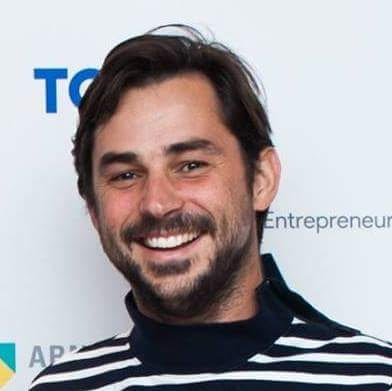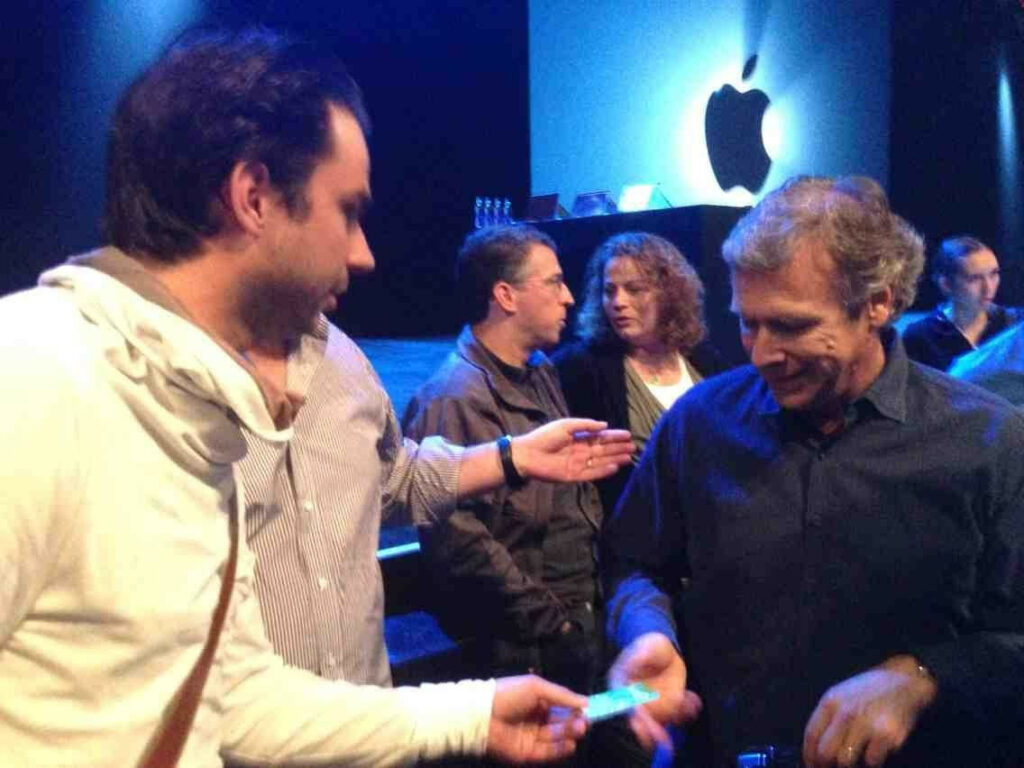Life-changing opportunities don’t show up often. When they do, you have to be ready for them. But if you’re in the flow you don’t wait for opportunities, you create them yourself. Michel Elings did just that. And this is his inspiring story.
Michel was a co-creator of TRVL, the first iPad-exclusive newsstand publication upon its debut in 2010. By 2012, it was voted best iPad magazine and the highest rated on iTunes, with 1.5 million readers. In 2013, he and his fellow Netherlands-based team members launched Prss, a platform for iPad magazine publishers which, following an Apple acquisition, became the foundation for Apple News.
Paul Quinn: What’s your background, Michel?
Michel Elings: I studied management. Afterward I got a few jobs, but I didn’t think the companies were particularly great for their people, and I thought if ever I can become an entrepreneur and start my own company with employees, I would love to do it in a way that would inspire folks and make it great to work with each other. I like to work with friends and people I like, people that give me energy.
So, along with my job I started doing my own thing on the side, which was helping people go from Windows to Mac in a personalized way. I had read the book The Power of Yes, which was just say yes to everything and see what life brings you. So, I said yes to everything and built up a really good clientele.
Paul Quinn: What attracted you to Apple at that time?
Michel Elings: I’m not a designer or developer at all. I’m an ideas guy. But I’ve always just really connected to the Apple brand. Over the last 20 years or so I’ve been a fan of everything Apple does. I’ve always read all the reports and blogs about Apple. I see it as a study.
Paul Quinn: How did being an ideas guy evolve for you?
Michel Elings: While doing this, I met with [a man named] Jochem over drinks and learned that he wrote a lot of travel stories and did photography. I told him I had an idea we could start together. I said, “What if we build a magazine based on all the old articles that you have, we provide those in English for a worldwide audience, and the iPad is the new channel to bring the magazine to the world?”
That’s how we started TRVL. A year into it, we had a good number of readers. But I really hated the software and felt we should build our own.

Paul Quinn: How did you go about that?
Michel Elings: We asked a number of investors if they would like to do a round with us, and except for one they were old clients of mine that I had helped move from Windows to Mac.
Paul Quinn: It sounds like you added the power of building relationships to the power of Yes.
Michel Elings: Yes, and we started building software with an old high school friend of mine, Thijs Zoon, co-founder and CTO in our new venture. Now we had a team. In three months, Thijs and a number of new colleagues and I built a complete software layer that we needed.
Paul Quinn: What was the vision at that point?
Michel Elings: We thought if we could produce this it would enable and elevate everyone else in the world to become a magazine publisher. It was not a big ask at that point but a big vision.
Paul Quinn: Once you had the software, where did you go from there?
Michel Elings: I knew one person at Apple here in the Netherlands and got in touch with them. I started doing all these demos. People loved my enthusiasm and could see that we were doing something great, so every time I finished a demo I asked, “Is there someone else who should see this?”
That led to another meeting that took me to the UK, and I got a ticket to the 2012 WWDC [Apple’s Worldwide Developers Conference], the biggest Apple conference in the world. And they said that we were one of the startups they would be featuring in a WWDC video showing what developers do with the platform and APIs that Apple provided. It was a VIP ticket, like the golden ticket in Charlie and the Chocolate Factory!
So, I went to the Moscone Center, in San Francisco, where two years earlier Steve Jobs had given his keynote. I was standing at the VIP entrance with every single blogger that I’ve read all these years, so I was surrounded by all my heroes.
Moscone is massive. Five-thousand people can sit in the auditorium and the VIPs go in first. When they opened the gates, everyone started running so I ran too, which resulted in me getting a really good position in the center of row six. The Apple senior team was in the first few rows. I was sitting between the CTOs of Facebook and Pinterest.
The keynote always starts with an inspiring video, and I got us in it. It was brief but we were in there! And I thought, Holy shit, I’m in San Francisco with a VIP ticket, we were in the video, all my dreams have come true!
I thought that was it.
The show lasted about two hours. When it ended, everyone started to leave the auditorium and I was following them, looking at all these backs drifting away. Then I looked back toward the stage and saw all the Apple executives mingling there and thought, This is my only chance in life I will ever get so close to such influential people.
There were security folks around but if you do it smart you disregard them! And right there was Eddy Cue [Apple’s senior vice president of services]. I knew that he was a massive dealmaker who played a major role in developing iTunes and the App Store. He was talking with someone else. At one point he looked at me and I said, “Hey, we were in the video.”
And he said “Congratulations.”
And I said, “Listen, we are making something far bigger than the magazine you saw in the video, and we are building the software you guys forgot to make.”
And he said, “Here’s my card, just send me an email.”
Paul Quinn: So, everyone else in the audience had left, but you stayed and stepped forward.
Michel Elings: Yes. I changed my direction from going out to going in. I think I was the only external person in the group. It was a pivotal moment for everything. And things went really, really fast after that. I had my calendar booked with massive numbers of appointments with people from Apple, but in the first meeting they already knew that I talked with Eddy Cue.
Paul Quinn: Word travels fast! What happened in those meetings?
Michel Elings: In the very first meeting I started asking for pretty much everything and got it – lots of marketing and promotion advice.
And then I thought, What if I went back in a few months and provided them with a demo of what we’re building? And I started telling that to everyone. Three or four months later, I went back and gave a demo to about 15-20 people. They really liked it.
Fast-forward — it resulted in my talking to really high-level people at Apple and eventually to their acquisition of our company. It was insane. The whole process was just unbelievable.
Paul Quinn: And to top if off, you wound up getting a job at Apple, didn’t you?
Michel Elings: Our whole team, about 16 people at that point, got jobs at Apple. We started working on Apple News. A number of folks from the team are still working there.

Paul Quinn: Tell me more about how the ideas in The Power of Yes influenced you.
Michel Elings: A yes gives you energy and provides everyone energy. No is a showstopper. I don’t like showstoppers, and I think that has to do with situations in my youth. I got ill quite early with my hip and had to go to the hospital a lot. I can still remember a time where I was laying in the hospital bed and saw all these folks playing in the snow. It doesn’t snow that much in the Netherlands, and I can still remember I hated that feeling of not being able to play in the snow as well.
So, I sincerely don’t like the no part or to have blockers around me. If there’s something blocking me, I find a way to remove it or go around it. That’s the power of yes for me.
Paul Quinn: What do you think blocks most people?
Michel Elings: Insecurity puts a massive weight on people. My wife and I hope to raise our children not to feel insecure. Because insecurity is the biggest blocker of actions. I always go against my insecurities.
Paul Quinn: Can you give an example of how you do that?
Michel Elings: I didn’t like to present or give a keynote. But I felt it was blocking me, so I started a presentation night where 200 people came in to give a presentation and I also gave a presentation. I thought it was a good way to get rid of my insecurity.
Paul Quinn: I do presentation coaching, and it’s true that the more you present the more secure you feel doing it. What are you working on now?
Michel Elings: We are now working on Oopen. Our vision is that everyone in the world should be able to become an entrepreneur. We give everyone the tools to start their businesses.
Paul Quinn: I hope Oopen is a big success. Any closing thoughts on the subject of asking, Michel?
Michel Elings: In the Netherlands we have a phrase, “Een brutaal mens heeft de halve wereld,”which roughly translates to “someone who dares to say something usually gets it done.” And another saying, “Nee heb je, ja kun je krijgen”, which basically means “No is a given until you ask.” I see a lot of truth in these sayings.
Paul Quinn: Thanks, Michel. I really appreciate your willingness to share your amazing story and insights with me.
Michel Elings: I never gave interviews about this, but for this book I made an exception. So, if there’s just one person that will act upon this story that would do it for me.

To contact Michel Elings visit him on LInkedIn.
Paul Quinn is author of a nearly completed book about asking as a life skill, which features portions of this content.

Love YES! Love this read. Love your spirit, Michel and your fast action. And I guess idea guys love idea guys 🙂 personally i still need to find my “Jochem”… and actually I go out for drinks quiet often 🙂 thanks Mr Quinn and Michel for this article.
Paul, I really enjoyed the interview and the message. I love how the Universe converged with opportunity. And Michael saw the opportunities and acted. At the beginning when he sprinted to the front and, on leaving, sprinted back when he could refer to his inclusion of their video.